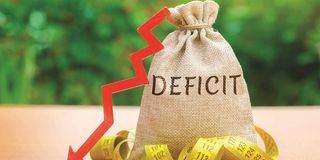Deficit financing that energises growth

Deficit financing is useful in funding development plans, but anyone using the tool should know how far they should go.
Carmen Reinhart, Chief Economist of World Bank, famously said “transparency of debt, credit, and terms of borrowing can help with creditor co-ordination and speed up debt reduction efforts.” Kenya’s fiscal deficit stands at approximately Sh1 trillion, which is roughly 8.1 percent of GDP. Usually, fiscal deficit takes place due to revenue deficit or an upsurge in capital expenditure.
It is usually financed through borrowing from the central bank, market, treasury bills, and bonds as well as external debts. Ukur Yatani, the Treasury Cabinet Secretary, while presenting this year’s Budget said “the fiscal deficit will be financed through net external financing of Sh280.7 billion and net domestic financing of Sh581.7 billion.”
Deficit financing is similar to debt financing but refers to specific practices used by governments to increase the number of debt instruments they use. Maynard Keynes believed that deficit helps countries climb out of economic recession, on the other hand, fiscal conservatives feel that governments should avoid deficits in favour of a balanced budget policy.
Deficit financing in underdeveloped countries promotes economic development. Its use becomes essential for financing the development plans. Kenya has to repay international debt along with interest, and the US dollar has strengthened against the shilling. For that, the government needs money. Another objective of this method of financing is to overcome low tax receipts and the losses of public sector enterprises for implementing antipoverty programmes.
Inflation
Deficit financing has various effects interrelated in many ways with inflation, capital formation, income distribution, and economic development. It is said that deficit financing is inherently inflationary since it increases aggregate expenditure and hence grows aggregate demand. The danger of inflation is always large, this is particularly true where deficit financing is used for non-productive outcomes such as war.
Due to the Russia-Ukraine war, Ukraine’s public sector deficit increased from $2 billion in March 2022 to more than $7 billion in May 2022 and is expected to be $38 billion early next year.
Whether deficit financing is inflationary or not depends upon the nature of financing. When it is undertaken for the purpose of building up useful capital during a short period of time, it is likely to improve productivity and ultimately increase the elasticity of supply curves. The increase in productivity can act as an antidote against price inflation.
In low-saving countries, deficit finance-led inflation becomes an important source of capital accumulation. The savings propensities by local and international investors could become considerably high due to appealing interest rates. As a result, aggregate savings of the community become larger, which can be used for capital formation to accelerate the level of economic development of the country. In June 2022, Kenya scrapped plans to issue a $1 billion Eurobond, citing high debt servicing costs and this was a wise decision.
The Central Bank of Kenya has issued several infrastructure bonds with good interest yields, encouraging savings, and are more sustainable compared to repaying international debt at higher interest rates.
If money collected through deficit financing is spent for public good, some sort of favourable distribution of income and wealth may be made.
This method of financing has certain multiplier effects on the economy. It encourages the government to use unemployed and underemployed resources. It is most popular to meet developmental expenditure as it does not impinge any trouble either to the taxpayers or to those lending to the government.
Nairobi Expressway
Kenya has witnessed many large infrastructure projects, from the SGR to the Nairobi Expressway, and many more ongoing projects financed through methods including deficit financing. This has resulted in generating income and employment in the economy.
However, deficit-led inflation tends to reduce the consumption propensity of the public and could widen income inequality. Inflation causes an adverse effect on aggregate savings and investment, trade unions tend to demand an increase in wages otherwise they engage in lockouts and strikes.
Deficit financing is useful in creating employment. Import and export policies should be framed in such a manner that the supply of essential goods may not fall.
Deficit financing is inevitable, but it has to be kept within the safe limit so that inflationary forces do not appear in the economy. But nobody knows the safe limit. In view of all this, it is an evil but a necessary evil.
Barot is a business and financial analyst.





